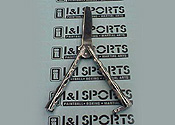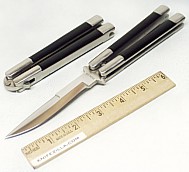The Balisong Collector Reviews I&I Sports Trainer Balisong
A "trainer" knife is a purposefully dull knife with no sharp edge and no pointed tip. They're sometimes called "training drones", but I don't particularly like the word "drone". I don't know why. I just don't. So, I prefer to use the term "trainer".
Some people look for a trainer version
of a balisong to practice manipulation techniques without the
fear of getting cut. But, I think you can usually accomplish this
goal better by simply putting some tape over the edge on your
regular (the term "live blade" is often used) balisong.
You can read some additional comments on this subject in this
essay: ![]()
The real purpose of training knives is combative training and sparring. Personally, I love a good knife fight... as long as all of the blades are dull and, when it's all over, we can all compare notes and laugh about our mistakes.
Some people try to make trainers out of live blades by just dulling the edge. Depending on the blade's original profile this can sometimes be done. But, for minimal safety, the "edge" on a trainer has to be pretty thick. A live blade get's very thin toward the edge. Even a dull edge will cut if it's thin enough. On most blade profiles, in order to get the edge thick enough for a minimally safe trainer, you have to grind off a lot of metal, maybe a third to a half of the blade's width. There just won't be much left.
And then there's the tip. A minimally safe trainer needs a thick, well-rounded tip. Much like the edge, to get a minimally safe tip on many live blades, you'd have to grind an inch or more off of the length of the blade.
Some people try to make minimally safe training knives from thick aluminum sheet stock. It's not hard to do. I've done it myself. You can cut the basic shape out with a hand-held jig saw and refine it with a simple bench grinder. This is possible because aluminum is a soft material. That's the problem. In sparring, the blades frequently knock together. Aluminum trainers quickly get dented, chipped and nicked. Even though the overall edge remains dull, those dents, nicks and chips quickly turn into an almost serrated edge which can give inflict a nasty rips and cut.
Wooden trainers are common. But, they're not very realistic. My instructor, Kurt Goodwin at API Combative Arts in Portland (www.kurtisgoodwin.com ), swore off wooden trainers quite some time ago after trying some good metal trainers. I agree entirely. Metal trainers are much more realistic both in terms of handling the knife and also in terms of tactile feedback.
In case you haven't noticed, I keep using the term "minimally safe." Even with proper training knives, knife sparring remains a dangerous game. Even with proper training knives, all participants must accept both the responsibility to be careful and also the possibility of injury. All participants should always wear suitable eye protection. And you should only train this way under the supervison of a qualified instructor.
I've long wanted a good balisong trainer so I was pleased to order one from I&I Sports, (http://www.iisports.com), their catalog #KO2000A. Here's the picture taken from their website:

For $12, I knew it wasn't gonna be a great balisong. I expected cheap, hollow pins that would break after just a day or two of manipulation and have to be replaced. I expected a worthless latch. I expected plenty of blade play.
So, when it arrived, I was pleasantly surprised to find pretty good looking pins, a reasonable latch, and a fairly tight blade.
I took my $12 purchase to one of the Saturday Knife Seminars at API Combative Arts here in Portland, Oregon to give it a try. This is what I bought the knife for and was looking very much forward to using it.
I'm disappointed to report that one of the handles broke in only my second match.
As you can see in these pictures, the knife broke because the skeleton pattern holes nearest the top of the handles are to close to the edge. The holes are to large and the material gets to thin and weak.
The two thin pieces on the "slotted" side of the handle cracked first and I noticed it but went on. Then, the thicker side also broke and I found myself with a useless "knife" flopping around in my hand. My opponent, wielding an Spyderco Endura Trainer, had suddenly gained a considerable advantage over me.
From this experience, I learned two important lessons that I'd like to share with you:
First, I can save you $12. If you're thinking about buying one of these I&I Sports trainers for your own combative training and sparring applications, don't. This product isn't up to the stress of serious training.
Second, if you're considering a weapon for self-defense, invest in the best you can get because there's nothing quite as annoying as having your weapon fail when you need it most. Fortunately, I found out the easy way, sparring.
Now, with that said, let me show you a couple of non-balisong trainers so you can get some idea of what a good trainer is like:
Notice how thick the edge is on this trainer and notice how nicely rounded the tip is.
This is a Rekat Escalator Trainer. This rather unique folding knife was designed by famous martial artist Bram Frank. Rekat no longer makes this knife, but Mr. Frank has since licensed the same basic design to Spyderco who offers it as the Sypderco Gunting. I've had a lot of fun with this trainer. That steep ramp on the spine makes this knife very difficult to disarm. Unfortunately, we also found that that rather steep ramp and horn on the spine make even the trainer rather dangerous. After a few nasty scrapes, we stopped using this one for sparring at API. I've since heard of police officers and security guards carrying just the Gunting trainer believing that even without a live edge, it's a very effective weapon.
Notice how the blade actually gets deliberately thicker at the tip. Notice how thick the edge is. In these respects, this is really an excellent trainer.
Unfortunately, I do not know of a good balisong trainer right now. I'm hopeful that one of the major manufacturers will offer one soon.
Knifezilla (http://www.knifezilla.com) offers a "trainer"
version of their "Pacific-Style" balisong (this is the
balisong that I've called the "Chinese Sidewinder."
You can read my review of the non-trainer version by clicking
on this icon ![]() ).
But, as you can see in this picture taken off of their website,
this "trainer" still has a pretty nasty looking tip.
).
But, as you can see in this picture taken off of their website,
this "trainer" still has a pretty nasty looking tip.

Knifzilla describes this knife as "perfect for hazard free bali training." Well, I don't know about you, but I don't think I want to train with that one. Even if the edge is dull, that point really doesn't look safe to me.
Several of the major manufacturers are now offering excellent trainer versions of conventional folding knives. In addition to the Gunting Trainer, Spyderco offers trainer versions of both the Endura and the Delica. Benchmade offers the AFCK as a trainer. I've used all of these and would recommend any of them. And, I've heard that Masters of Defense offers trainers of some of their models, though I've never seen one.
API stands for American, Philippine, and Indonesian. Guru Kurt Goodwin currently teaches Philippine Arnis, Indonesian Silat, Loation Kick boxing, and Tibetan Nine-headed Snake Fist. All of these can incorporate an edged weapon, but Arnis and Silat are the two that most emphasize edged weapons. So, in our knife sparring seminars, you'll most likely see students display elements of these forms.